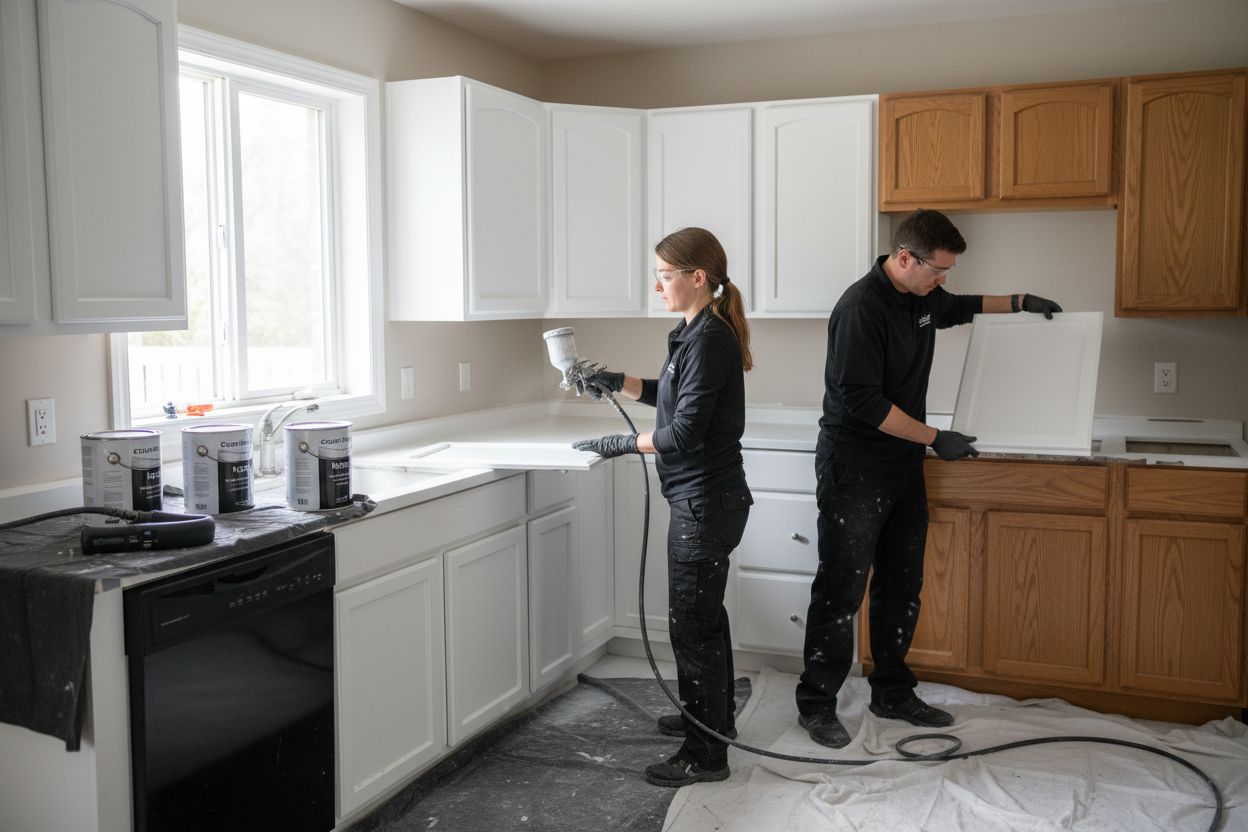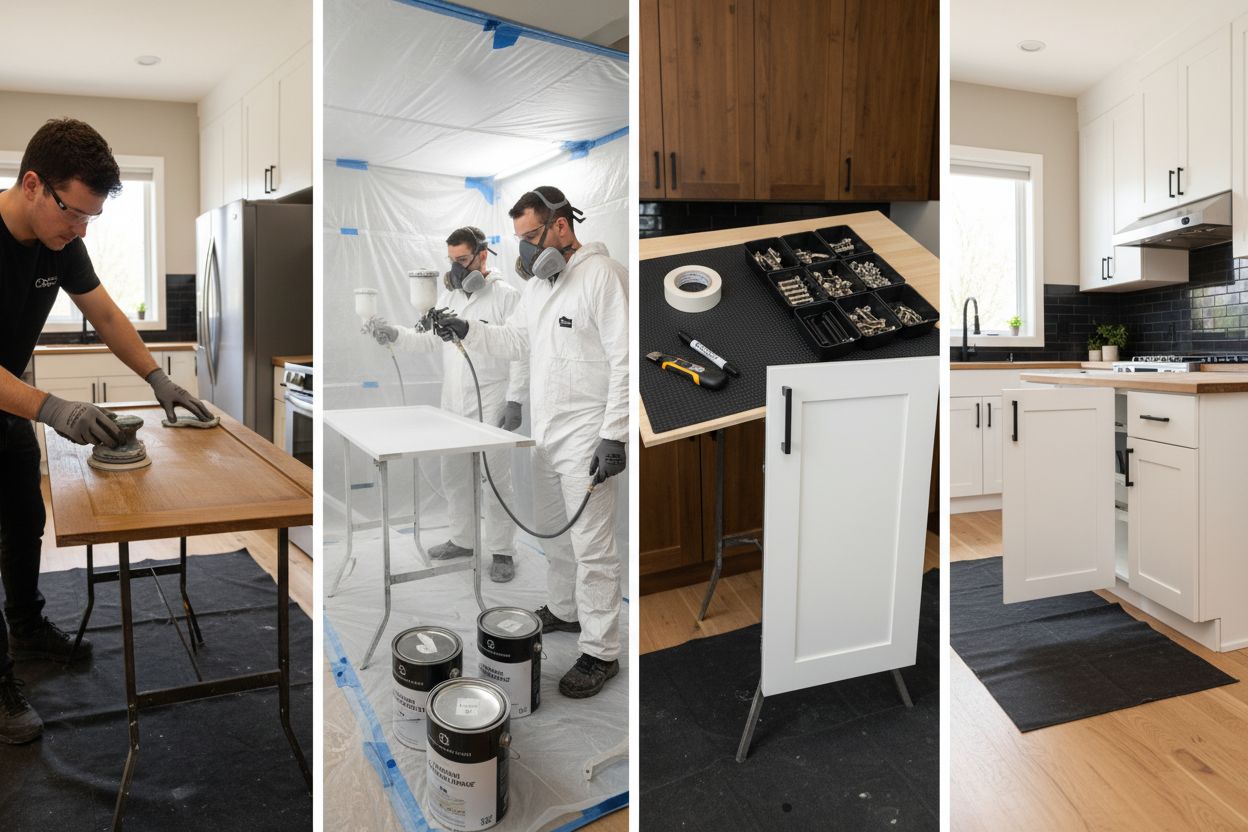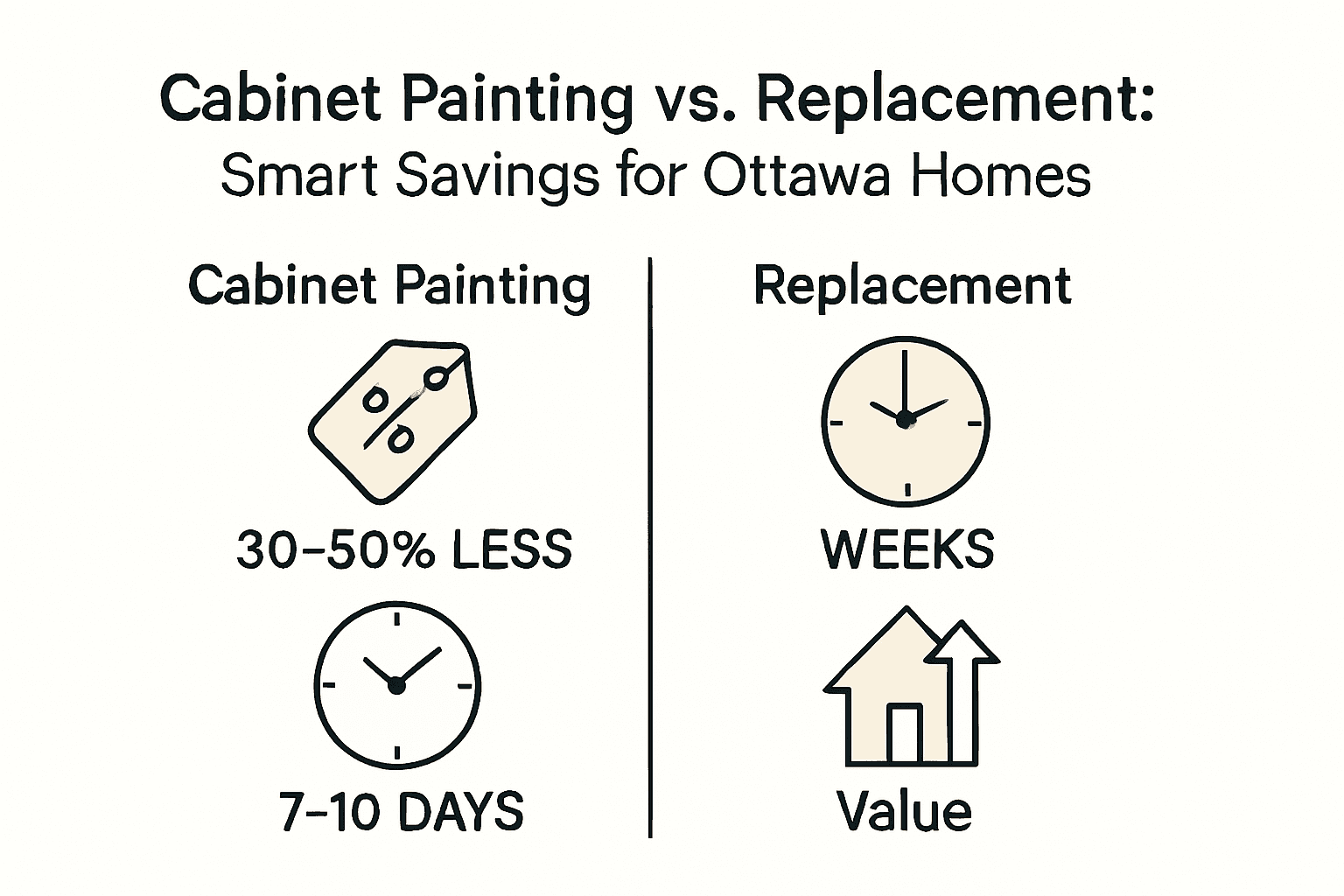Cabinet Painting FAQ: Complete Expert Guide Ottawa
- demoore5506
- Oct 20
- 8 min read
Updated: Oct 24

Did you know that a professionally painted kitchen can add thousands of dollars in resale value to your home? Many people underestimate what truly goes into cabinet painting and fall for the myth that it is a simple weekend task. Knowing the differences between DIY shortcuts and professional processes helps you avoid costly mistakes and ensures your cabinets keep looking fresh and flawless for years.
Key Takeaways
Point | Details |
Professional Expertise Needed | Cabinet painting requires specialized techniques and skills that often exceed DIY capabilities. Attempting to DIY can result in poor finishes that may degrade home value. |
Important Preparation and Process | A thorough preparation process is key, involving cleaning, sanding, and priming to ensure a durable, professional result. Skipping these steps can lead to unsatisfactory outcomes. |
Investment vs. Renovation Cost | Professional cabinet painting typically costs 30-50% less than full cabinet replacement, offering an economical upgrade option without significant disruption. |
Maintenance for Longevity | Proper care, including gentle cleaning and avoiding harsh chemicals, is crucial in extending the lifespan of painted cabinets, supporting the investment made. |
Table of Contents
What Cabinet Painting Involves and Common Myths
Cabinet painting is far more complex than simply applying a fresh coat of paint to your kitchen cabinetry. It’s a meticulous process that requires professional expertise, precision, and specific techniques to transform your existing cabinets into a showroom-worthy finish. Many homeowners mistakenly believe they can achieve professional results with a weekend DIY project, but the reality is quite different.
The actual cabinet painting process involves several critical steps that are often misunderstood. These include:
Thorough surface preparation, which means complete cleaning, degreasing, and sanding of all cabinet surfaces
Proper priming using specialized shellac-based or bonding primers that ensure paint adhesion
Precise paint application using professional-grade spray equipment for an ultra-smooth, factory-like finish
Strategic drying and curing periods to guarantee long-lasting durability
One of the most persistent myths about cabinet painting is that it’s a quick, inexpensive solution that anyone can tackle. In reality, professional cabinet painting services require significant skill and investment in high-quality materials. Attempting a DIY approach often leads to uneven surfaces, visible brush strokes, premature chipping, and an overall unprofessional appearance that can actually decrease your home’s aesthetic value.
Understanding the nuanced process of cabinet painting helps homeowners make informed decisions. While the initial investment might seem higher than a DIY approach, professional services provide a seamless, durable transformation that can dramatically enhance your kitchen’s appearance without the massive expense and disruption of a full renovation.
Popular Cabinet Paint Types and Finishes
Navigating the world of cabinet paint types and finishes can be overwhelming for homeowners seeking to transform their kitchen’s aesthetic. The right paint and finish not only dramatically impact your kitchen’s visual appeal but also determine the long-term durability and maintenance requirements of your cabinetry.
When exploring paint options, homeowners typically encounter several primary categories:
Latex Paints: Water-based, quick-drying, and low-odor
Alkyd Paints: Oil-based, providing exceptional durability and smooth finish
Acrylic Paints: Offering excellent adhesion and resistance to wear
Chalk Paints: Popular for creating a matte, vintage appearance
Finish selection is equally critical. Understanding the right paint finish can make the difference between a professional-looking result and a mediocre transformation. The most common finishes include:
Here’s a comparison of common cabinet paint types and finishes:
Type/Finish | Key Features | Best For |
Latex Paint | Water-based Low odor Quick drying | Easy application Low VOC needs |
Alkyd Paint | Oil-based Very durable Smooth finish | High-traffic kitchens |
Acrylic Paint | Strong adhesion Resists wear | Long-lasting results |
Chalk Paint | Matte look Easy to distress | Vintage or rustic appearance |
Satin Finish | Soft sheen Moderate durability | Subtle, modern kitchens |
Semi-Gloss Finish | Highly washable Moisture resistant | Busy family kitchens |
High-Gloss Finish | Bright shine Shows imperfections | Contemporary, statement looks |
Matte Finish | No shine Modern look | Sleek, low-traffic kitchens |
Satin: Soft, subtle sheen with moderate durability
Semi-Gloss: Highly washable and resistant to moisture
High-Gloss: Extremely shiny, shows imperfections easily
Matte: Low-shine, modern aesthetic with less cleaning resilience
Professional cabinet painters understand that selecting the right paint goes beyond aesthetic preferences. Factors like kitchen humidity, cooking frequency, and household traffic play significant roles in determining the most suitable paint type and finish. While DIY enthusiasts might be tempted to choose based on color alone, professional services consider comprehensive environmental factors to ensure a lasting, beautiful result.
Step-By-Step Cabinet Painting Process Explained
Transforming kitchen cabinets through professional painting is a meticulous process that requires precision, skill, and systematic execution. Far from a simple weekend project, cabinet painting demands specialized techniques to achieve a flawless, long-lasting finish that enhances your kitchen’s overall aesthetic and value.
The comprehensive cabinet painting process typically follows these critical stages:
Preparation: Complete removal of cabinet doors, drawers, and hardware
Cleaning: Thorough degreasing and deep cleaning of all surfaces
Sanding: Careful surface abrasion to ensure proper paint adhesion
Priming: Application of specialized bonding primer
Painting: Professional spray application of premium paint
Finishing: Strategic drying and protective clear coat application
Prepping cabinets for paint requires exceptional attention to detail. Professional painters understand that each step is crucial - rushing or skipping any phase can compromise the entire project’s quality.

This means meticulously protecting surrounding areas, using professional-grade equipment, and applying multiple thin, even coats instead of thick, uneven layers.
The entire process typically spans 7-10 days, with most of that time dedicated to proper preparation, precise painting, and strategic drying periods. While DIY enthusiasts might view this as time-consuming, professional services ensure a factory-like finish that dramatically transforms your kitchen without the massive expense and disruption of a full renovation. The investment in professional cabinet painting pays dividends through enhanced aesthetic appeal, increased home value, and a durable finish that withstands daily kitchen demands.
Expected Timelines and Disruption to Homes
Homeowners are often concerned about the potential disruption caused by cabinet painting projects. Understanding the realistic timeline and impact on daily household activities can help manage expectations and reduce anxiety about the transformation process. Professional cabinet painting is designed to minimize interference with your home’s routine while delivering exceptional results.
A typical cabinet painting project follows a structured timeline that carefully balances efficiency with quality:
Days 1-2: Initial preparation and protection of kitchen space
Days 3-5: Comprehensive cleaning, sanding, and priming
Days 6-8: Professional paint application and initial drying
Days 9-10: Final finishing, clear coat, and hardware reinstallation
Understanding the cabinet painting process reveals that professional services are strategically designed to reduce household disruption. Unlike full kitchen renovations that can take weeks or months, cabinet painting allows homeowners to maintain partial kitchen functionality throughout most of the project. Professionals typically create designated work zones, protect countertops and appliances, and ensure minimal dust and paint exposure to living areas.
The key to managing home disruption lies in careful planning and professional expertise. While the project temporarily limits full kitchen access, most families can still use basic kitchen functions. Experienced painters work efficiently, communicating progress and potential daily limitations. The short-term inconvenience yields a dramatic transformation - a brand-new kitchen appearance without the extensive time, cost, and chaos of a complete renovation. Homeowners can expect to regain full kitchen functionality within 10-14 days, with a stunning result that breathes new life into their living space.
Cost Factors, Savings, and Value Compared
Cabinet painting represents a strategic investment for homeowners seeking to transform their kitchen’s appearance without the astronomical costs of a full renovation. Understanding the financial dynamics of this home improvement approach can help Ottawa residents make informed decisions about their kitchen upgrade strategy.
The primary cost factors influencing cabinet painting pricing include:
Cabinet Size: Total linear feet of cabinetry
Surface Complexity: Number of doors, drawers, and intricate details
Current Cabinet Condition: Extent of preparation required
Paint Quality: Grade of professional-grade paint selected
Hardware Replacement: Optional upgrades during refinishing
Understanding DIY cabinet painting versus professional services reveals significant financial advantages. Professional cabinet painting typically costs 30-50% less than full cabinet replacement, with most homeowners investing between $2,500-$6,500 for a complete kitchen transformation. This approach delivers substantial savings compared to a full kitchen renovation, which can easily exceed $25,000-$50,000.
Beyond immediate financial savings, cabinet painting offers long-term value through increased home aesthetics and potential property value enhancement. Professional refinishing provides a factory-like finish that protects underlying cabinetry, extends furniture lifecycle, and refreshes your kitchen’s appearance without structural modifications. The investment pays dividends through improved visual appeal, extended cabinet durability, and a cost-effective alternative to complete kitchen remodeling that minimizes household disruption and maximizes return on investment.

Durability, Warranty, and Care Tips
Professional cabinet painting goes beyond aesthetic transformation - it’s an investment in long-term kitchen durability and appearance. Homeowners need to understand the intricate balance between high-quality paint application, proper maintenance, and warranty protection to maximize their cabinet refinishing results.
Care and maintenance for professionally painted cabinets involve several critical practices:
Daily Cleaning: Use soft microfiber cloths and mild, non-abrasive cleaners
Avoid Harsh Chemicals: Skip ammonia-based or acidic cleaning solutions
Moisture Management: Wipe down surfaces immediately after cooking or spills
Hardware Care: Gently clean handles and knobs to prevent paint chipping
Temperature Control: Minimize extreme heat and humidity exposure
Understanding durable cabinet paint reveals that professional services typically offer comprehensive warranties ranging from 3-6 years. These warranties protect against common issues like:
Premature paint chipping
Color fading
Adhesion failures
Unexpected surface degradation
The longevity of painted cabinets depends not just on initial application, but ongoing maintenance and environmental factors. Professional painters recommend periodic gentle cleaning, avoiding direct sunlight exposure, and addressing any minor wear promptly. By following these guidelines, homeowners can extend their cabinet’s pristine appearance well beyond the initial warranty period, ensuring a lasting investment that continues to enhance kitchen aesthetics and functionality.
Reimagine Your Kitchen Without the Stress of Renovation
If you worry about the hassle, cost, or lengthy disruption of a full kitchen remodel, you are not alone. The article highlighted how complicated proper cabinet painting can be, from meticulous prep work and high-level application, to selecting the best finishes that hold up in busy households. Many homeowners try to save money and end up disappointed with uneven results, wasted weekends, or surfaces that chip far too soon.
You deserve a kitchen that feels modern, welcoming, and durable. At Ottawa Cabinet Painting, we specialize in transforming your existing cabinets through a professional process proven to deliver a silky smooth finish. Unlike quick fixes or risky DIY, our service includes deep cleaning, expert surface prep, and application of premium paints built for lasting beauty. We efficiently minimize disruption to your home and back every project with a six-year warranty, so your investment is protected. Are you ready to enjoy a kitchen that truly feels like the heart of your home? Visit our main site to view inspiring transformations and request your free quote today. Make your next kitchen upgrade a rewarding experience.
Frequently Asked Questions
What are the critical steps involved in the cabinet painting process?
The cabinet painting process involves several important steps: thorough surface preparation (cleaning, degreasing, and sanding), proper priming with specialized primers, precise paint application usually with spray equipment, and strategic drying and curing periods to ensure long-lasting durability.
How do I choose the right type of paint for my cabinets?
Selecting the right cabinet paint involves considering several factors such as durability, adhesion, and aesthetic. Common options include latex paints for quick drying, alkyd paints for exceptional durability, acrylic paints for resistance to wear, and chalk paints for a vintage look. Also, consider the kitchen environment, humidity, and traffic.
How long can I expect the cabinet painting process to take?
A typical cabinet painting project takes about 7-10 days. This includes preparation, cleaning, sanding, priming, painting, and finishing. Professional services ensure efficiency while maintaining high-quality results, allowing homeowners to have partial kitchen functionality throughout the project.
What maintenance tips should I follow for painted cabinets?
To maintain professionally painted cabinets, regularly clean them with soft microfiber cloths and mild non-abrasive cleaners. Avoid harsh chemicals, manage moisture by wiping up spills quickly, and ensure temperature control to prevent damage. Proper care can extend the life and appearance of your cabinets significantly.
Recommended
Comments